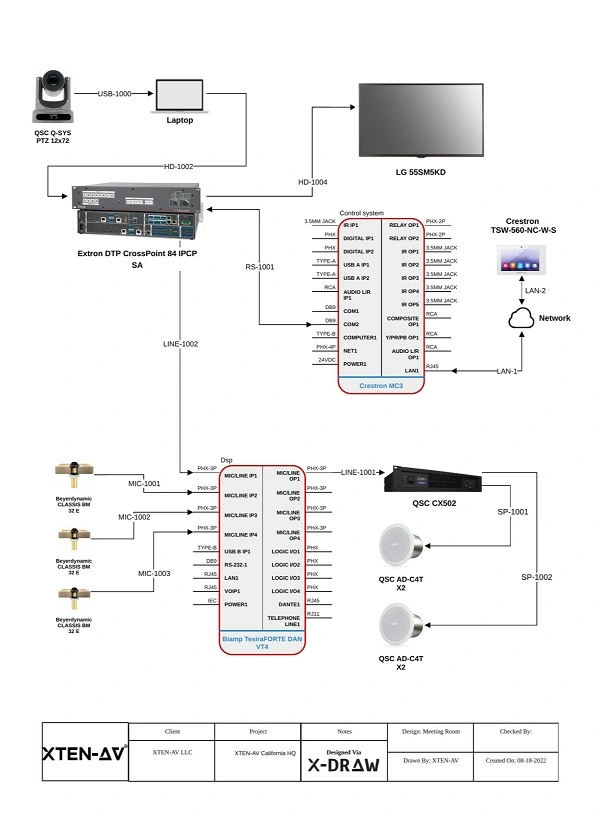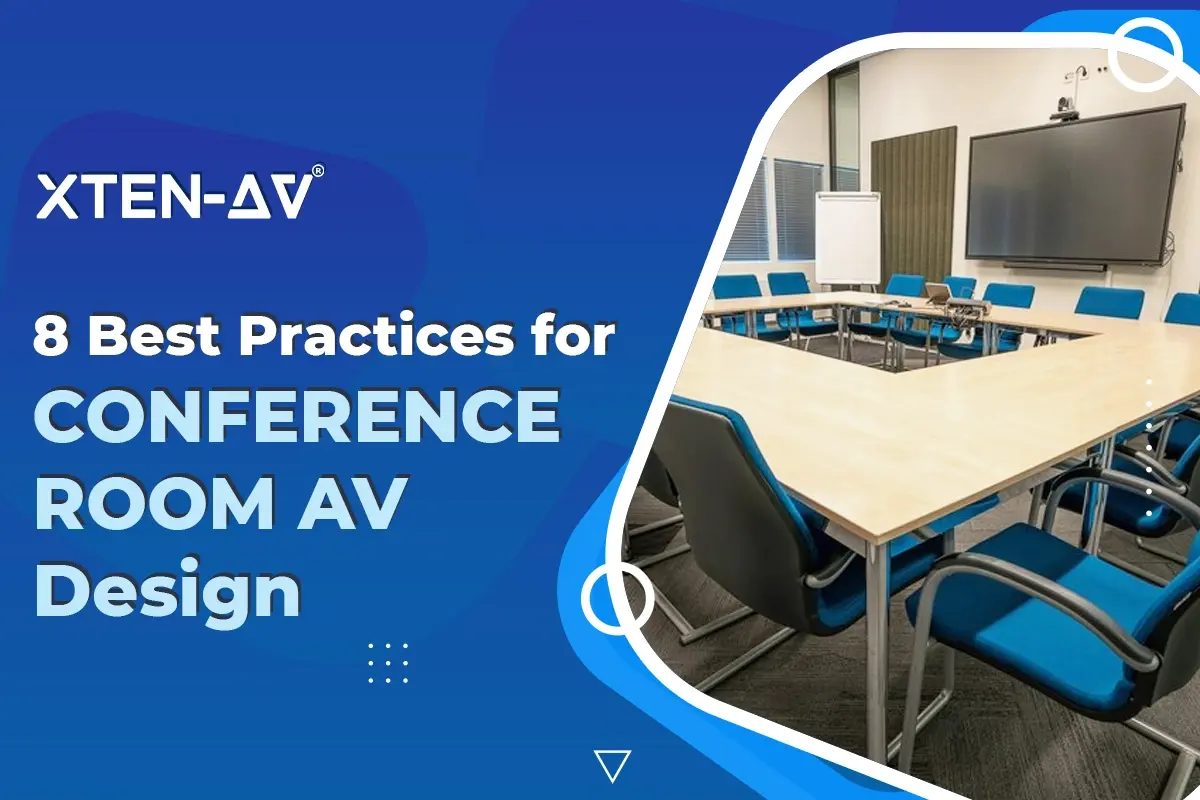8 Best Practices for Conference Room AV Design
Welcome to the heart of collaborative innovation – the world of conference room AV design. As we start exploring, we envision conference rooms not merely as physical spaces but as dynamic hubs where technology converges to enhance connectivity, creativity, and productivity.
From the intricacies of user interface design to the nuances of acoustics and connectivity, every facet contributes to an ecosystem that facilitates smooth interactions and impactful presentations.
Join us as we unravel the art and science of designing conference rooms that transcend the traditional, embracing the future of work through cutting-edge conference room audio visual solutions.
1. Assess User Needs for Conference Room AV Design:
Before diving into the Conference room AV design process, conduct a thorough needs assessment and understand the specific requirements of the conference room users. Identify the primary purpose of the space, the expected number of participants, and any unique technological or functional requirements. This initial step ensures the Conference room audio visual design aligns with the practical needs of the users.
2. Offer an Intuitive User Interface Design:
Create an intuitive user interface for conference room audio visual setup that minimizes complexity. Users should be able to easily control audio, video, and other conference room AV design components without extensive training. Implement touch panels or user-friendly interfaces that offer a seamless experience, fostering efficient collaboration during meetings.
3. Pay Attention to Room Acoustics and Sound Management:
Pay careful attention to conference room AV acoustics to ensure clear audio communication. Consider factors such as wall materials, ceiling height, and furniture placement to optimize sound quality. Incorporate acoustic treatments and echo-canceling technology to mitigate background noise and enhance the overall audio experience.
4. Ensure Optimized Lighting Control:
Implement lighting control systems that enhance visibility without causing glare or distractions. Integrating automated lighting solutions can facilitate the adjustment of light levels based on the specific needs of different activities within the conference room, such as presentations, video conferences, or collaborative discussions.
5. Plan Network Infrastructure and Bandwidth:
Ensure the conference room has a robust network infrastructure capable of supporting high-bandwidth AV transmissions. Consider the demands of video conferencing, content sharing, and other collaborative applications. Adequate network planning helps prevent latency issues, ensuring a smooth and uninterrupted audio video experience.
6. Provide Remote Monitoring and Support:
Integrate remote monitoring and support capabilities into the conference room AV design system. This allows audio visual administrators to proactively identify and address potential issues, minimizing downtime and ensuring the reliability of the conference room technology. Remote support tools can also facilitate troubleshooting and updates without requiring physical intervention.
7. Include Scalability in Conference Room Audio Visual Design:
Plan conference room audio visual design with scalability in mind, anticipating future technological advancements. Choose conference room audio visual equipment and infrastructure that can easily accommodate upgrades or additions to meet evolving business needs. This forward-thinking approach helps future-proof the conference room AV setup, reducing the frequency of major overhauls.
8. Finally Ensure Proper Training and Documentation:
After completing the conference room AV installation. Provide comprehensive training for end-users and support staff to ensure they can effectively operate and troubleshoot the Audio visual system for the conference room. Additionally, create detailed documentation outlining system functionalities, troubleshooting procedures, and contact information for technical support. This empowers users to make the most of the AV technology and facilitates efficient issue resolution when needed.
10x Your Productivity With Our Conference Room Audio Visual Drawing Software!
Upload & create floor plans:
X-DRAW enables its users to upload or create new floor plans for their conference rooms. In case you already have a floor plan, you can simply upload it and make any necessary changes. This makes the designing process very simple and hassle-free.
Automated signal flow diagram:
If you are using AutoCAD or any other av drawing tool, you are manually drawing the signal flow diagram, right? Well, with our conference room audio visual design software, all this is automated. Get ready to save yourself from the struggles of manual drawing.
Library of 1.5M products from 5200 brands:
Explore from a vast library of products. X-DRAW offers a huge library of AV products. Having a library handy is a great add-on when it comes to conference room AV design. The best part is you can create your own library.
Pre-made conference room design template:
Want to skip the hard work of designing from scratch? We’ve got you covered. X-DRAW also has pre-made conference room design templates. You can directly edit these templates according to the client’s requirements.

How To Access the Best Conference Room Audio Visual Drawing Software!
Get a 15-day free trial, NO CREDIT CARD REQUIRED!
Or book a demo session with industry experts with 15+ years of experience.
AV Design Mastery + Winning Proposals = 10x Productivity!
- Automatic Cable Labeling & Styling
- 100+ Free Proposal Templates
- Upload & Create Floor Plans
- 1.5M Products from 5200 Brands
- AI-powered ‘Search Sense'
- Legally Binding Digital Signatures
Conclusion
As our journey through conference room AV design concludes we recognize the transformative power embedded in the thoughtful integration of technology.
A well-designed conference room is not just a convergence of wires and screens but a catalyst for collaboration, innovation, and shared ideas.
In this dynamic landscape, where communication transcends physical boundaries, the significance of audio visual system design cannot be overstated.
The nuances of acoustics, the brilliance of visual displays, and the adaptability of interfaces all play pivotal roles in shaping an environment where ideas flow seamlessly.
Let’s carry forward the insights gained, embracing the ever-evolving possibilities that technology affords, and continue to create spaces that inspire, connect, and drive the collaborative spirit forward.
Frequently Asked Questions
Conference Room audio video design significantly enhances productivity by providing seamless audiovisual communication tools. Well-designed spaces encourage collaboration, allowing teams to share ideas effortlessly and engage in dynamic discussions, fostering a more innovative work environment.
When selecting audio equipment, consider the room’s acoustics, the number of participants, and the types of activities conducted. Implementing echo-canceling technology, strategically placed microphones, and soundproofing solutions contribute to clear and immersive audio experiences.
Conference Room AV Design can embrace hybrid work models by incorporating flexible connectivity options, advanced video conferencing systems, and automated lighting controls. These features ensure a seamless experience for both in-person and remote participants, fostering inclusivity and collaboration.
Scalability is crucial for future-proofing AV setups, allowing for easy integration of emerging technologies and accommodating evolving business needs. Choosing equipment and infrastructure with scalability in mind ensures that conference rooms can adapt to advancements without requiring frequent and costly overhauls.
Organizations can ensure effective user training by providing comprehensive documentation and hands-on training sessions. Emphasize the intuitive nature of the AV interface, create user guides, and offer ongoing support to empower users to confidently operate and troubleshoot the AV system, maximizing its potential.


